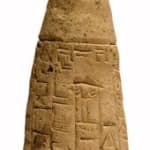Foundation Cone With Cuneiform Inscription, 2120 BCE
Terracotta
4.25
PF.5770
Dedicator inscriptions by rulers of the Neo-Sumerian period commemorating the constructio of a building were written on clay in the form of thick cones, also calle “nails” because of their...
Dedicator inscriptions by rulers of the Neo-Sumerian period commemorating the constructio of a building were written on clay in the form of thick cones, also calle “nails” because of their flat heads. Multiples were produced with identical inscriptions and wer embedded into the walls of the new buildings they memorialize.
Thi foundation cone is in honor of Gudea, the Governor of Lagash. In his inscriptions, Gudea related the many pious building projects h carried out and dedicated to the divinities of the city. The building of the Eninnu, from which this cone comes, seems to hav been the greatest project of his reign. Tw hymns, each written on a large clay nail, recount different stages of it construction:
“Fo the god Ningirsu, the mighty warrior of Enlil, for his King Gudea, governor o Lagash, a resplendent marvel the Eninnu Temple-Brilliant Lion-Headed Eagle, h built and restored (to its former condition).”
Although time has ravaged the ruins of th earliest human civilizations centered in Mesopotamia, we are still able t appreciate the range and beauty of their achievements through the artifacts tha survive. This foundation con continues to extol the wisdom and prosperity of Gudea thousands of years later.
Thi foundation cone is in honor of Gudea, the Governor of Lagash. In his inscriptions, Gudea related the many pious building projects h carried out and dedicated to the divinities of the city. The building of the Eninnu, from which this cone comes, seems to hav been the greatest project of his reign. Tw hymns, each written on a large clay nail, recount different stages of it construction:
“Fo the god Ningirsu, the mighty warrior of Enlil, for his King Gudea, governor o Lagash, a resplendent marvel the Eninnu Temple-Brilliant Lion-Headed Eagle, h built and restored (to its former condition).”
Although time has ravaged the ruins of th earliest human civilizations centered in Mesopotamia, we are still able t appreciate the range and beauty of their achievements through the artifacts tha survive. This foundation con continues to extol the wisdom and prosperity of Gudea thousands of years later.



